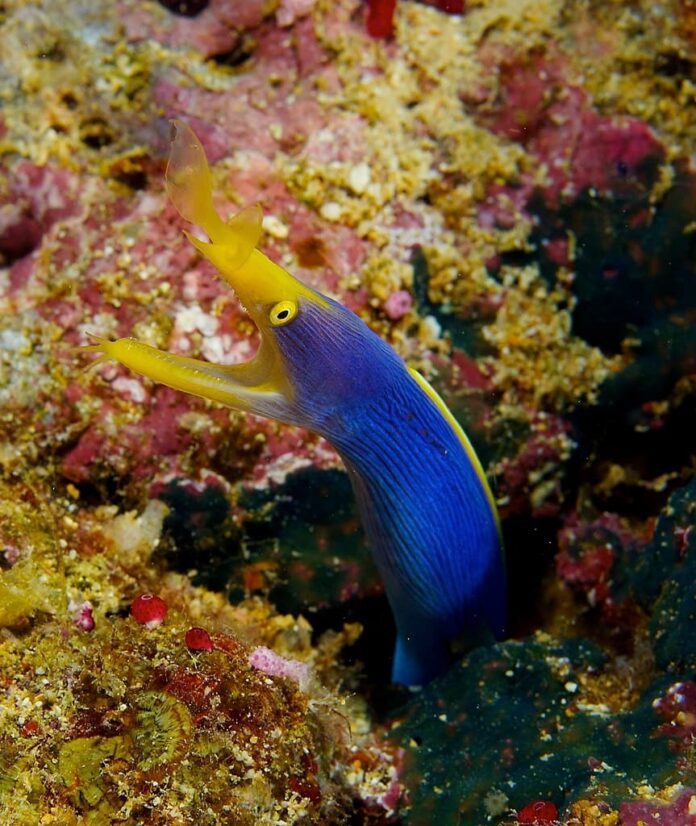The ribbon eel is a bright eel species that looks absolutely striking, probably the most colorful moray in the family. Are they always so flamboyant? I will answer your questions regarding the coloration of this eel species below. There are actually many cool things about them, and we shall discuss them all today.
1Appearance

First of all, only adult male ribbon eels have the bright blue color. Juveniles and adult females are either entirely yellow or yellow with some blue to their posterior. Males can be as long as 65 to 94 centimeters while females can be up to 130 centimeters long. Apart from the color, you can easily recognize a ribbon eel by its expanded anterior nostrils. You cannot mistake their long protruding nostrils and the 3 fleshy filaments from the lower jaw tip with any other eels.
What’s so fascinating about them is that the color will also change when the male changes his sex to female. So, all ribbon eels were born female but they have to switch their gender at one point. A male ribbon eel is capable of changing his sex to female if there is a shortage of natural females. The cycle goes like this:
- Juvenile: This is the black phase, the eel has a bright yellow dorsal fin that runs the length of its dark black body.
- Male: As it matures, the color will change from black to bright electric blue with an equally yellow dorsal fin.
- Female: Then the male continues to grow until it reaches a length of over 1 meter, and its color changes to yellow. In this female stage, they will find a mate, lay their eggs, and die within a month.
2Behavior

It is common for divers to see these eels with their heads and anterior bodies protruding from crevices in sand. At the same time, they also use their nostrils to sense vibrations in the water for both hunting and self-protection. Many think that they are aggressive because ribbon eels always open their jaws widely when a diver approaches. While exposing their razor-like teeth and looking intimidating, these eels are just breathing. Nothing to be afraid of. In fact, they are not even territorial among their peers. It is absolutely normal for two male ribbon eels to share a cave together for a long period of time. And if this is the case, one of them will change their gender at one point in order to survive and reproduce.
3Feeding & Habitats

You probably already know, ribbon eels are carnivorous; and their diet consists of shrimps and small fish. Along with that, they also prey on any crustaceans and small animals that swim too close to their hole. Anything their strong jaws can catch, they will eat those.
Ribbon eels inhabit lagoons and reefs in the Indo-Pacific Ocean, all the way from East Africa to Australia and French Polynesia. In those waters, they like living on healthy coral reefs as well as damaged reefs. As long as the bottom composition has rubble and sand that they can bury themselves in, these eels are happy. A ribbon eel usually stays in the same home for months or even years, considering its lifespan is up to 20 years.
Because of their beautiful appearance, the main threat to their lives is the pet trade. The combination of the long slender body with a dragon-like head makes this creature very popular among the pet trade. Ribbon eels can live for up to 20 years in the wild but only a month in captivity. They will stop eating and eventually die. This is why only advanced aquarists should keep them due to the special care requirements.
Related Post: Most Dangerous Eels In The World




